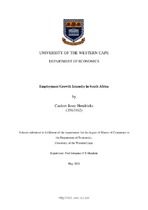| dc.description.abstract | The following research paper is based on employment intensity, arguing the notion that an increase in economic growth alone does not necessary increase the rate of employment in South Africa. In fact, other additional macroeconomic factors determine changes in the rate of employment, along with economic growth. This research measured the employment numbers in each South African sector with reference to sector-specific gross value added, to determine the level of elasticity of employment in each sector. This was done by extracting quarterly data in-between the year 1995 to 2019. For each sector, a unit root test was estimated, an ARDL bound test for cointegration, an error correction model. A stability and diagnostic test were conducted to test the fluidity of each regression model. The coefficient of each sector modelled indicated no correlation between employment and economic growth. In “all sectors”, the results of GVA were not influential enough to implement positive change in the levels of employment, thus, leading to jobless growth. | en_US |

